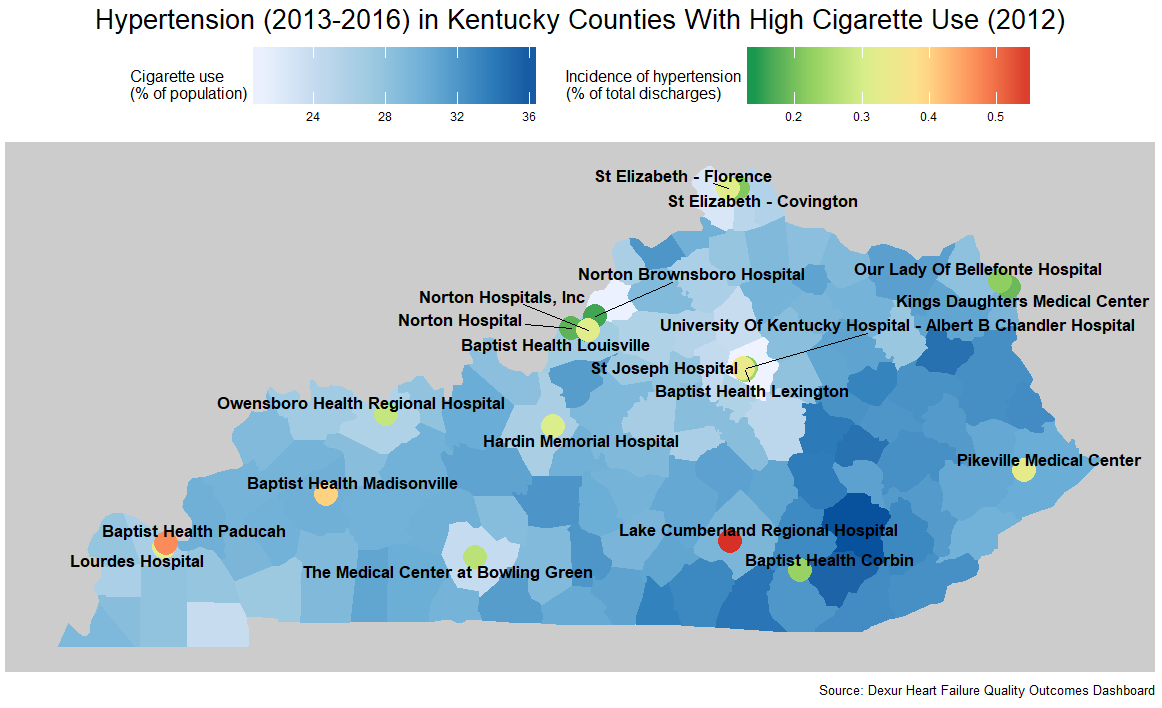Cigarette Use Data May Help Pinpoint Patients At Particular Risk of Malignant Hypertension in Kentucky; Louisville at Low Risk
In Hypertension
Get Dexur’s Personalized Hospital Specific Presentation on Quality, Safety, Compliance & Education
By: James Pitt May. 28, 2018
People in industrialized countries have an over 90% lifetime risk of developing hypertension, according to a 2007 review in The Lancet. Many diseases cause hypertension. Primary or “essential” hypertension is defined as hypertension with no such cause. This definition is misleading because diet, exercise, and several known genes affect the risk of primary hypertension.
Smoking is particularly risky in patients with hypertension. In these patients, smoking increases the risk of progressing to malignant hypertension, a condition with the rapid onset that can cause organ damage.
Dexur analysts examined hypertension in Kentucky, the state with the second-highest cigarette use in 2016 CDC data. The sample was CMS inpatients discharged with hypertension as their primary diagnosis, from hospitals with more 3,000 Medicare-eligible inpatient discharges per year. County-level data on cigarette use was extracted from Lindgren et. al 2012 under Creative Commons open access.


The three hospitals with the lowest percentage of hypertension patients were all in Louisville. Hypertension was of least concern at Baptist Health Louisville (Louisville, KY), where only 0.14% had hypertension as their primary diagnosis. Norton Women's and Children's Hospital (Louisville, KY) was an exception to this trend, with hypertension as primary diagnosis in 0.32% of all Medicare discharges. Lake Cumberland Regional Hospital (Somerset, KY) had the highest proportion of patients with hypertension as their primary diagnosis, at 0.55% of its total CMS inpatient discharges. Clay County had the highest cigarette use, at 36% of the population. Fayette County had the lowest, at 20.6%. Jefferson County, where Louisville is located, had 26.7%.
Among large hospitals, smoking rates and hypertension rates did not track closely. (It has long been suspected that smoking raises overall blood pressure, not just malignant hypertension risk, but a 2015 meta-analysis found that it does not). Hospitals with high rates of hypertension, or situated in counties with high cigarette use, may benefit from monitoring the subpopulation of smokers at risk for hypertension among their patients.
DEXUR PRO MEMBERS GET ACCESS TO:
- Total Discharges All Inpatient
- Total Discharges After Exclusion All Inpatient
- Total Discharges Hypertension
- Total Discharges After Exclusion Hypertension
- All Cause 30 Day Readmissions Hypertension
- Readmission Rate Hypertension
- Total Discharges DRG 304
- Total Discharges After Exclusion DRG 304
- Total Discharges DRG 305
- Total Discharges After Exclusion DRG 305
- DRG 304 as percent of total hypertension
- DRG 304 as percent of total hypertension after exclusion
- Hypertension discharges as percent of total CMS inpatient discharges
From 2013-2016, at:
Baptist Health Corbin (Corbin, KY), Baptist Health Lexington (Lexington, KY), Baptist Health Louisville (Louisville, KY), Baptist Health Madisonville (Madisonville, KY), Baptist Health Paducah (Paducah, KY), Hardin Memorial Hospital (Elizabethtown, KY), Kings Daughters Medical Center (Ashland, KY), Lake Cumberland Regional Hospital (Somerset, KY), Lourdes Hospital (Paducah, KY), Norton Brownsboro Hospital (Louisville, KY), Norton Hospital (Louisville, KY), Norton Hospitals, Inc (Louisville, KY), Our Lady Of Bellefonte Hospital (Ashland, KY), Owensboro Health Regional Hospital (Owensboro, KY), Pikeville Medical Center (Pikeville, KY), St Elizabeth - Covington (Edgewood, KY), St Elizabeth - Florence (Florence, KY), St Joseph Hospital (Lexington, KY), The Medical Center at Bowling Green (Bowling Green, KY), University Of Kentucky Hospital - Albert B Chandler Hospital (Lexington, KY)
ABOUT THE AUTHOR
